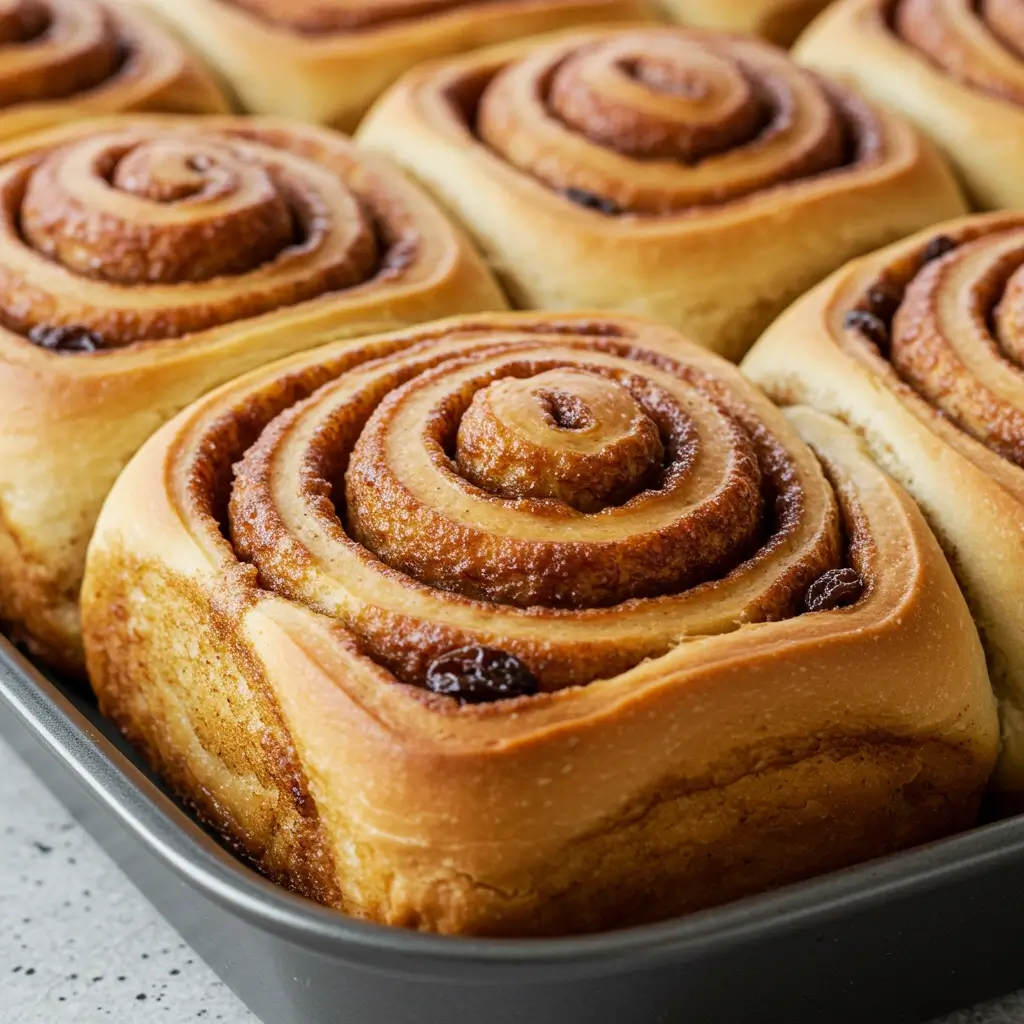There’s something magical about waking up to the smell of freshly baked cinnamon rolls. The sweet, spicy aroma fills the air, promising a comforting and delicious start to the day. Overnight cinnamon rolls are the ultimate breakfast indulgence, combining convenience with mouthwatering flavor. Whether you’re hosting a brunch or simply treating yourself, these rolls are sure to impress. In this article, we’ll walk you through everything you need to know to make these delightful pastries, from ingredients to serving suggestions.
Ingredients
To create the perfect overnight cinnamon rolls, you’ll need a selection of simple ingredients that, when combined, produce a rich and flavorful treat. Here’s what you’ll need:
- 4 cups all-purpose flour
- 1/4 cup granulated sugar
- 1 packet (2 1/4 tsp) instant yeast
- 1 tsp salt
- 1 cup warm milk (dairy or plant-based)
- 1/4 cup melted butter (dairy or dairy-free)
- 2 large eggs
- 1/2 cup brown sugar
- 1 tbsp cinnamon
- 1/4 cup raisins (or nuts, optional)
- Icing (powdered sugar + milk, to taste)
These ingredients come together to create a soft, fluffy dough filled with a sweet cinnamon swirl and topped with a luscious icing.
Instructions
Making overnight cinnamon rolls is easier than it might seem at first glance. By preparing the dough the night before, you can enjoy a stress-free morning with minimal effort. Follow these simple steps:
- Mix Dry Ingredients:
In a large bowl, combine the flour, granulated sugar, instant yeast, and salt. Mix well to ensure the ingredients are evenly distributed. - Add Wet Ingredients:
In another bowl, whisk together the warm milk, melted butter, and eggs. Gradually combine this wet mixture with the dry ingredients, stirring until a dough forms. - Knead:
Turn the dough onto a floured surface and knead for about 5 minutes until it becomes smooth and elastic. - First Rise:
Place the dough in a greased bowl, cover it with a towel, and let it rise overnight in the fridge. This slow rise develops the dough’s flavor and texture. - Roll and Fill:
The next morning, roll out the dough into a rectangle on a floured surface. Spread with melted butter, and then sprinkle evenly with brown sugar, cinnamon, and optional raisins or nuts. - Shape Rolls:
Roll the dough tightly from one end to the other to form a log. Slice into 12 equal pieces and place them in a greased baking dish. - Second Rise:
Cover the rolls and let them rise for about 30 minutes until puffy. - Bake:
Preheat the oven to 350°F (175°C). Bake the rolls for 25-30 minutes until they are golden brown and cooked through. - Icing:
Mix powdered sugar with a splash of milk to create a smooth icing. Drizzle over the cooled rolls and serve.
Nutrition Facts
Understanding the nutritional content of your homemade treats is important for mindful indulgence. Here’s the breakdown per cinnamon roll:
- Calories: 220
- Protein: 4g
- Carbs: 32g
- Fat: 8g
- Sugar: 6g
These cinnamon rolls are not only delicious but also a moderate indulgence that can fit into a balanced diet.
How to Serve
Cinnamon rolls are a versatile treat that can be enjoyed in a multitude of ways, making them suitable for various occasions, from a cozy breakfast at home to a festive holiday gathering. Here are some detailed serving suggestions to enhance your culinary experience and elevate your enjoyment of these delightful rolls:
Classic Style
The classic way to serve cinnamon rolls is undeniably satisfying. Enjoy them warm, allowing the gooey icing to melt slightly into the soft, fluffy dough. For an authentic touch, consider using a cream cheese icing for a rich, tangy contrast to the sweetness of the rolls. Pairing these rolls with a hot cup of coffee or tea can turn a simple breakfast into a comforting ritual. The warmth of the beverage complements the rolls perfectly, creating a cozy atmosphere ideal for leisurely mornings. For added depth, consider choosing a flavored coffee, such as hazelnut or cinnamon, which can enhance the overall experience.
Add Some Crunch
To elevate your cinnamon rolls, consider adding a bit of crunch. After drizzling the icing, sprinkle a handful of finely chopped nuts—such as pecans, walnuts, or almonds—over the top. This not only introduces a delightful textural contrast but also adds a nutty flavor that beautifully complements the sweet and spicy notes of cinnamon. Alternatively, you could use granola for an unexpected twist. Choose a granola that includes oats, seeds, and perhaps some dried fruit, which will enhance the flavor profile and provide additional nutritional benefits. This crunchy topping is especially delightful if you’re serving cinnamon rolls as part of a brunch spread, where guests can enjoy a variety of textures.
With Fresh Fruit
Serving cinnamon rolls alongside fresh fruit is an excellent way to balance their sweetness and add a refreshing element to your meal. A bowl of mixed berries—such as strawberries, raspberries, blueberries, and blackberries—can brighten the plate and provide a tart contrast to the sugary rolls. For a seasonal touch, consider using sliced peaches or nectarines in the summer, or warm, spiced apples in the fall. The natural acidity of the fruit cuts through the richness of the icing, creating a harmonious balance. Additionally, you could create a simple fruit salad with a drizzle of honey and a sprinkle of mint for a refreshing side dish that complements the cinnamon rolls beautifully.
For Dessert
Transform your cinnamon rolls into an indulgent dessert by adding a scoop of vanilla ice cream on top. The warm rolls and cold ice cream create a delightful temperature contrast, making each bite a luxurious experience. You can also drizzle a bit of chocolate sauce or caramel over the top for an extra layer of decadence. For a gourmet touch, consider using flavored ice cream, such as salted caramel or cinnamon bun, to enhance the flavor profile even further. This combination is perfect for entertaining guests or celebrating special occasions, as it turns a simple treat into a show-stopping dessert that is sure to impress.
Creative Variations
For those looking to experiment beyond traditional cinnamon rolls, consider serving them with flavored cream cheeses or whipped toppings. A maple-flavored cream cheese spread can add a unique twist, or you could whip up a batch of cinnamon whipped cream for a delightful topping. You might also want to explore pairing your cinnamon rolls with flavored syrups, such as maple or blueberry, allowing guests to customize their rolls according to their preferences.
Conclusion
Cinnamon rolls are not just a delightful treat; they are a versatile canvas for creativity. Whether you stick to classic pairings or venture into more imaginative territory, the way you serve your cinnamon rolls can elevate the entire experience. From cozy breakfasts to extravagant desserts, these serving suggestions will enhance your enjoyment of this beloved pastry, making every bite a memorable one.
To ensure your overnight cinnamon rolls turn out perfectly, consider these helpful tips:
Additional Tips for Perfecting Your Dough Rolls
When it comes to making the perfect dough rolls, there are several key factors that can influence the outcome. Here’s a more detailed breakdown of essential tips to ensure your rolls turn out fluffy, flavorful, and visually appealing.
Temperature Matters
The temperature of your ingredients, particularly the milk, plays a crucial role in activating the yeast effectively. Yeast is a living organism that thrives in warm environments, but it has its limits. Ideally, the milk should be warmed to about 100°F to 110°F (37°C to 43°C). This temperature range is perfect for yeast activation, as it encourages the yeast cells to become active and multiply, producing carbon dioxide that helps your dough rise.
If the milk is too hot—above 120°F (49°C)—it can kill the yeast cells, leading to a flat, dense dough that won’t rise properly. Conversely, if the milk is too cold, the yeast may become sluggish, resulting in a slow or negligible rise. To check the temperature, you can use a kitchen thermometer or simply test it with your finger; it should feel warm but not uncomfortable. Always remember to stir the warm milk gently to distribute the heat evenly before adding the yeast.
Kneading Technique
Kneading is an essential step in dough preparation that helps develop gluten—a protein that gives the dough its elasticity and structure. Proper kneading is crucial for achieving that light, airy texture we all love in rolls.
To knead effectively, turn the dough out onto a lightly floured surface. Use the palms of your hands to push the dough away from you, then fold it back over itself. Rotate the dough a quarter turn and repeat this process for about 8-10 minutes. You should notice the dough becoming smoother and more elastic as you work.
If at any point the dough feels sticky and begins to cling to your hands or the work surface, don’t hesitate to add a little more flour, a tablespoon at a time. However, be cautious not to overdo it; too much flour can lead to dry, dense rolls. Instead, aim for a soft, slightly tacky dough that springs back when poked.
Overnight Rise
Allowing your dough to rise overnight in the refrigerator is a fantastic technique that enhances both flavor and texture. This slow fermentation process allows the yeast to develop more complex flavors, resulting in a richer taste. The cool environment also helps to manage the fermentation rate, leading to a dough that is easier to shape and handle.
To do this, simply prepare your dough as per the recipe, and after the initial mixing and kneading, place it in a lightly greased bowl. Cover it tightly with plastic wrap or a lid to prevent it from drying out, and place it in the refrigerator overnight.
If you’re pressed for time, an alternative is to allow the dough to rise at room temperature. This method can be effective, but the time needed will vary depending on the ambient temperature—typically, a 1-2 hour rise should suffice. Keep an eye on the dough; it should double in size and feel airy when ready.
Customizing Fillings
One of the most delightful aspects of making rolls is the opportunity for customization. While classic rolls are delicious on their own, adding fillings can elevate them to a new level. The possibilities are endless, so don’t hesitate to get creative!
- Sweet Fillings: Consider incorporating chocolate chips, dried cranberries, or cinnamon sugar for a sweet twist. For a decadent option, try swirling in a rich Nutella or a sweet cream cheese filling. Simply spread your chosen filling over the rolled-out dough before rolling it back up and shaping it into rolls.
- Savory Fillings: For a savory option, think about mixing in herbs, cheeses, or sautéed vegetables. A blend of garlic and fresh herbs can make for an aromatic filling that pairs beautifully with the soft roll. Cheese varieties like mozzarella or cheddar can also add a deliciously gooey texture when baked.
- Layering Flavors: You can even combine sweet and savory elements for a unique flavor profile. For instance, a layer of cream cheese with herbs combined with a sprinkle of caramelized onions can yield a surprisingly delightful result.
Don’t shy away from experimentation—your preferences and creativity can lead to wonderful new flavor combinations! Just remember to adjust the amount of sugar or salt in your dough recipe accordingly if you are adding particularly sweet or salty fillings.
Conclusion
By paying attention to these detailed aspects of dough preparation, you can significantly improve the quality of your rolls. From the right temperature for activating yeast to mastering kneading techniques and exploring creative fillings, each step is vital in crafting the perfect dough rolls. Happy baking!
FAQs
Q: Can I make these rolls ahead of time?
A: Yes, the dough can be prepared and stored in the refrigerator overnight, making it a convenient option for busy mornings. You can also freeze the shaped rolls before the second rise for up to a month. Thaw overnight in the fridge before baking.
Q: Can I use a different type of flour?
A: All-purpose flour works best for this recipe, but you can use bread flour for a chewier texture. Whole wheat flour can be used for a healthier alternative, but the texture may be denser.
Q: How do I store leftover cinnamon rolls?
A: Store any leftover rolls in an airtight container at room temperature for up to 3 days. For longer storage, freeze them in a sealed container and reheat them before serving.
Q: Can I make these rolls vegan?
A: Absolutely! Use plant-based milk and dairy-free butter to make these rolls vegan-friendly.
Conclusion
Overnight cinnamon rolls are a delightful way to start your day with a sweet and comforting treat. Their soft, fluffy texture, combined with the rich cinnamon-sugar filling and creamy icing, makes them a favorite for breakfast or brunch gatherings. With simple ingredients and easy steps, you can enjoy the luxury of homemade cinnamon rolls without the morning hassle. Whether you’re a seasoned baker or a beginner, this recipe is sure to become a cherished part of your repertoire. So, gather your ingredients, follow the steps, and treat yourself to the indulgence of freshly baked cinnamon rolls. Enjoy!
Print
Overnight Cinnamon Rolls Recipe
Ingredients
-
- 4 cups all-purpose flour
-
- 1/4 cup granulated sugar
-
- 1 packet (2 1/4 tsp) instant yeast
-
- 1 tsp salt
-
- 1 cup warm milk (dairy or plant-based)
-
- 1/4 cup melted butter (dairy or dairy-free)
-
- 2 large eggs
-
- 1/2 cup brown sugar
-
- 1 tbsp cinnamon
-
- 1/4 cup raisins (or nuts, optional)
-
- Icing (powdered sugar + milk, to taste)
Instructions
-
- Mix Dry Ingredients:
In a large bowl, combine the flour, granulated sugar, instant yeast, and salt. Mix well to ensure the ingredients are evenly distributed.
- Mix Dry Ingredients:
-
- Add Wet Ingredients:
In another bowl, whisk together the warm milk, melted butter, and eggs. Gradually combine this wet mixture with the dry ingredients, stirring until a dough forms.
- Add Wet Ingredients:
-
- Knead:
Turn the dough onto a floured surface and knead for about 5 minutes until it becomes smooth and elastic.
- Knead:
-
- First Rise:
Place the dough in a greased bowl, cover it with a towel, and let it rise overnight in the fridge. This slow rise develops the dough’s flavor and texture.
- First Rise:
-
- Roll and Fill:
The next morning, roll out the dough into a rectangle on a floured surface. Spread with melted butter, and then sprinkle evenly with brown sugar, cinnamon, and optional raisins or nuts.
- Roll and Fill:
-
- Shape Rolls:
Roll the dough tightly from one end to the other to form a log. Slice into 12 equal pieces and place them in a greased baking dish.
- Shape Rolls:
-
- Second Rise:
Cover the rolls and let them rise for about 30 minutes until puffy.
- Second Rise:
-
- Bake:
Preheat the oven to 350°F (175°C). Bake the rolls for 25-30 minutes until they are golden brown and cooked through.
- Bake:
-
- Icing:
Mix powdered sugar with a splash of milk to create a smooth icing. Drizzle over the cooled rolls and serve.
- Icing:
Nutrition
- Serving Size: one normal portion
- Calories: 220
- Sugar: 6g
- Fat: 8g
- Carbohydrates: 32g
- Protein: 4g





